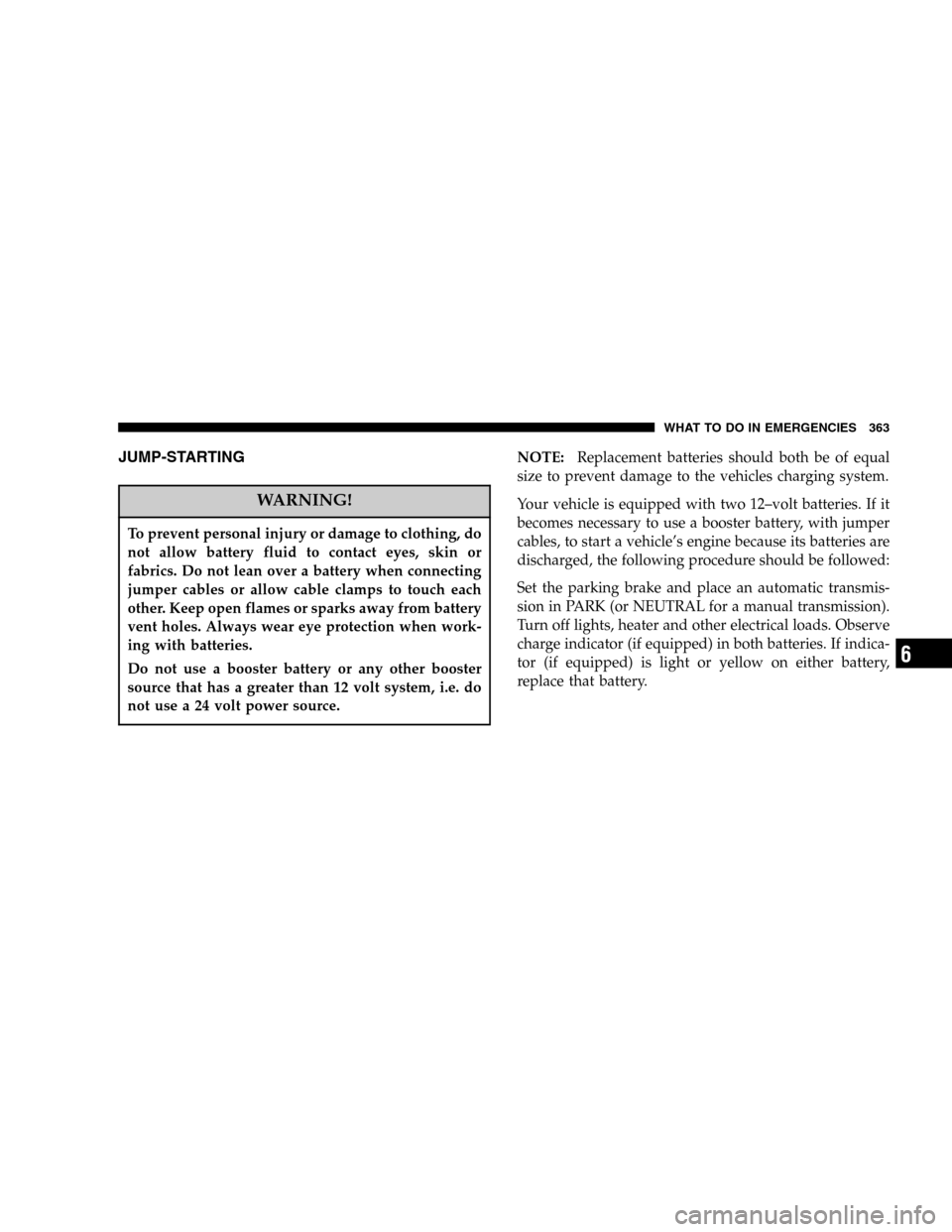Page 350 of 493
HAZARD WARNING LIGHTS
The Hazard Warning switch is mounted on the top of the
steering column as shown in the illustration.To engage the Hazard Warning lights, depress the button
on the top of the steering column. When the Hazard
Warning switch is activated, all directional turn signals
will flash off and on to warn oncoming traffic of an
emergency. Push the button a second time to turn off the
flashers.
This is an emergency warning system and should not be
used when the vehicle is in motion. Use it when your
vehicle is disabled and is creating a safety hazard for
other motorists.
When you must leave the vehicle to seek assistance, the
Hazard Warning lights will continue to operate even
though the ignition switch is OFF.
NOTE:With extended use, the Hazard Warning lights
may discharge your battery.
Hazard Light Warning Switch
350 WHAT TO DO IN EMERGENCIES
Page 357 of 493
4. By rotating the wheel wrench clockwise, raise the
vehicle until the wheel just clears the surface.
WARNING!
Raising the vehicle higher than necessary can make
the vehicle unstable and cause an accident. It could
slip off the jack and hurt someone near it. Raise the
vehicle only enough to remove the tire.
5. Remove the wheel nuts and pull the wheel off. Install
the spare wheel and wheel nuts with the cone shaped end
of the nuts toward the wheel on 2500/3500 single rear
wheel (SRW) models. On 3500 dual rear wheel models
(DRW) the lug nuts are a two piece assembly with a flat
face. Lightly tighten the nuts. To avoid risk of forcing the
vehicle off the jack, do not fully tighten the nuts until the
vehicle has been lowered.
6. Using the wheel wrench, finish tightening the nuts
using a crisscross pattern. Correct nut tightness is 135 ft.
lbs. (183 N·m) torque for 2500/3500 single rear wheel
WHAT TO DO IN EMERGENCIES 357
6
Page 363 of 493

JUMP-STARTING
WARNING!
To prevent personal injury or damage to clothing, do
not allow battery fluid to contact eyes, skin or
fabrics. Do not lean over a battery when connecting
jumper cables or allow cable clamps to touch each
other. Keep open flames or sparks away from battery
vent holes. Always wear eye protection when work-
ing with batteries.
Do not use a booster battery or any other booster
source that has a greater than 12 volt system, i.e. do
not use a 24 volt power source.
NOTE:Replacement batteries should both be of equal
size to prevent damage to the vehicles charging system.
Your vehicle is equipped with two 12–volt batteries. If it
becomes necessary to use a booster battery, with jumper
cables, to start a vehicle’s engine because its batteries are
discharged, the following procedure should be followed:
Set the parking brake and place an automatic transmis-
sion in PARK (or NEUTRAL for a manual transmission).
Turn off lights, heater and other electrical loads. Observe
charge indicator (if equipped) in both batteries. If indica-
tor (if equipped) is light or yellow on either battery,
replace that battery.
WHAT TO DO IN EMERGENCIES 363
6
Page 366 of 493

WARNING!
Any procedure other than above could result in:
1. Personal injury caused by electrolyte squirting
out the battery vent;
2. Personal injury or property damage due to battery
explosion;
3. Damage to charging system of booster vehicle or
of immobilized vehicle.
With Portable Starting Unit
There are many types of these units available. Follow the
manufacturer’s instructions for necessary precautions
and operation.
CAUTION!
It is very important that the starting unit operating
voltage does not exceed 12 Volts D.C. or damage to
battery, starter motor, alternator, or electrical system
may occur.
FREEING A STUCK VEHICLE
If vehicle becomes stuck in snow, sand, or mud, it can
often be moved by a rocking motion. Move the gear
selector rhythmically between DRIVE and REVERSE
(automatic transmissions) and between 1st and RE-
VERSE (manual transmissions), while applying slight
pressure to the accelerator.
In general, the least amount of accelerator pedal pressure
to maintain the rocking motion without spinning the
wheels or racing the engine is most effective. Racing the
engine or spinning the wheels, due to the frustration of
366 WHAT TO DO IN EMERGENCIES
Page 372 of 493

▫Front Axle Universal Drive Joints And Pivot
Bearings............................394
▫Body Lubrication.....................394
▫Windshield Wiper Blades................395
▫Windshield Washers...................395
▫Exhaust System......................396
▫Cooling System.......................397
▫Fan ...............................402
▫Charge Air Cooler (Inter-Cooler)..........402
▫Hoses And Vacuum/Vapor Harnesses.......402
▫Brake System........................403
▫Clutch Linkage.......................405
▫Clutch Hydraulic System................405▫Rear Axle And 4X4 Front Driving Axle Fluid
Level..............................405
▫Transfer Case — If Equipped.............406
▫Manual Transmission — If Equipped.......406
▫Automatic Transmission................407
▫Front Wheel Bearings..................409
▫Selection Of Lubricating Grease...........410
▫Noise Control System Required Maintenance &
Warranty...........................411
▫Appearance Care And Protection From
Corrosion...........................416
�Integrated Power Module.................420
�Vehicle Storage........................423
�Replacement Light Bulbs.................424
372 MAINTAINING YOUR VEHICLE
Page 373 of 493
�Bulb Replacement......................424
▫Headlight (Halogen)/Front Park And
Turn Lights.........................424
▫Tail, Stop, Turn And Backup Lights.........428
▫Center High-Mounted Stoplight With
Cargo Light.........................430
▫Cab Top Clearance Lights — If Equipped....431
▫Tailgate ID Lights (Dual Rear Wheels) —
If Equipped.........................433▫Rear Light Bar ID Marker (Dual Rear Wheel) –
If Equipped.........................434
▫Side Marker Lights (Dual Rear Wheels)......435
▫Fog Lights..........................436
�Fluid Capacities........................437
�Fluids, Lubricants And Genuine Parts........438
▫Engine.............................438
▫Chassis............................439
MAINTAINING YOUR VEHICLE 373
7
Page 375 of 493

ONBOARD DIAGNOSTIC SYSTEM (OBD II)
Vehicles equipped with California emissions controls
have a sophisticated onboard diagnostic system called
OBDII. This system monitors the performance of the
emissions, engine, and automatic transmission control
systems. When these systems are operating properly,
your vehicle will provide excellent performance and fuel
economy, as well as engine emissions well within current
government regulations.
If any of these systems require service, the OBD II system
will turn on the “Malfunction Indicator Light.” It will
also store diagnostic codes and other information to
assist your service technician in making repairs. Al-
though your vehicle will usually be driveable and not
need towing, see your dealer for service as soon as
possible.CAUTION!
Prolonged driving with the “Malfunction Indicator
Light” on could cause further damage to the emis-
sion control system. It could also affect fuel economy
and driveability. The vehicle must be serviced before
any emissions tests can be performed.
If the “Malfunction Indicator Light” is flashing,
severe catalytic converter damage and power loss
will soon occur. Immediate service is required.
REPLACEMENT PARTS
Use of genuine Mopar�parts for normal/scheduled
maintenance and repairs is highly recommended to in-
sure the designed performance. Damage or failures
caused by the use of non-Mopar parts for maintenance
and repairs will not be covered by the manufacturer’s
warranty.
MAINTAINING YOUR VEHICLE 375
7
Page 383 of 493

Always check the condition of the used oil. This can give
you an indication of some engine problems that might
exist.
•Thin, black oil indicates fuel dilution.
•Milky discoloration indicates coolant dilution.
Clean the area around the oil filter base. Remove the filter
from the underside of the vehicle using a cap style oil
filter wrench.
Clean the gasket surface of the filter mount. The filter
gasket can stick on the filter mount. Make sure it is
removed.
Change the engine oil filter with every engine oil change.
Only a high quality MOPAR filter should be used to
assure most efficient service.
CAUTION!
The filtering medium of other aftermarket filters
may disintegrate. Debris from failed filters may plug
the piston oil cooling nozzles, resulting in scuffed
pistons and engine failure.
CAUTION!
Fill the oil filter element with clean oil before
installation. Use the same type oil that will be used
in the engine. When filling the oil filter, prevent
foreign material from falling into the filter. Severe
engine damage may occur.
Apply a light film of lubricating oil to the sealing surface
of the filter gasket before installing the filter.
MAINTAINING YOUR VEHICLE 383
7